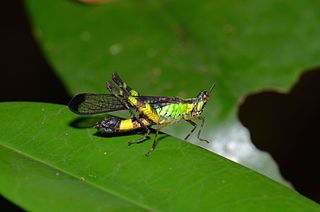
The Acrididae are the predominant family of grasshoppers, comprising some 10,000 of the 11,000 species of the entire suborder Caelifera. The Acrididae are best known because all locusts are of the Acrididae. The subfamily Oedipodinae is sometimes classified as a distinct family Oedipodidae in the superfamily Acridoidea. Acrididae grasshoppers are characterized by relatively short and stout antennae, and tympana on the side of the first abdominal segment.

The Melanoplinae are a subfamily of grasshoppers in the family Acrididae. They are distributed across the Holarctic and Neotropical realms. They are one of the two largest subfamilies in the Acrididae. As of 2001 the Melanoplinae contained over 800 species in over 100 genera, with more species being described continuously. The genera of the Melanoplinae are classified in 7 tribes, including Conalcaeini, Dactylotini, Dichroplini, Jivarini, Melanoplini, Podismini, and Prumnini.

The Romaleidae or lubber grasshoppers are a family of grasshoppers, based on the type genus Romalea. The species in this family can be found in the Americas.

Oedipoda is the type genus of grasshoppers, in the subfamily Oedipodinae. Species include the European "blue-winged grasshopper", Oedipoda caerulescens.

Eumastacidae are a family of grasshoppers sometimes known as monkey- or matchstick grasshoppers. They usually have thin legs that are held folded at right angles to the body, sometimes close to the horizontal plane. Many species are wingless and the head is at an angle with the top of the head often jutting above the line of the thorax and abdomen. They have three segmented tarsi and have a short antenna with a knobby organ at the tip. They do not have a prosternal spine or tympanum. Most species are tropical and the diversity is greater in the Old World. They are considered primitive within the Orthoptera and feed on algae, ferns and gymnosperms, the more ancient plant groups.

Eumastacoidea is a superfamily within the order Orthoptera. The family has a mainly tropical distribution. Some of the characters of the members of the superfamily are the lack of an abdominal tympanum, wings if present widen towards the tip, the antennae are short in some groups the hindlegs are spread out laterally at rest.

Chorotypidae is a family of tropical Asian grasshoppers, formerly included within the family Eumastacidae. These grasshoppers have a head that rises above the level of the thorax and short antennae. Some species have reduced wings, others have wings that widen towards the tips and still others have a flattened leaf-like shape. They lack abdominal tympani.

The Thericleidae are a family of grasshoppers within the order Orthoptera and superfamily Eumastacoidea. They have exceptionally stubby antennae even for the Caelifera, with most species have a characteristic "horse-headed" look in profile.
Pyrgacris is a small genus of grasshoppers in the monotypic family Pyrgacrididae. The two species in the genus Pyrgacris are found only on Reunion Island.

Erianthus is a genus of grasshoppers restricted to Southeast Asia. They occur in Japan, northeast India, Myanmar, Thailand, Vietnam, South China including Hong Kong, and extend east to Sumatra. In the past some neotropical species were also included in the genus. They have narrow ranges and species are identifiable only by their characteristics of male and female genitalia.

The Tropidopolinae are a subfamily of Acrididae in the Orthoptera: Caelifera. Species can be found in Africa, southern Europe and Asia.

The Hemiacridinae are a subfamily of Acrididae in the Orthoptera: Caelifera. Species can be found in Africa, and Asia.

Romaleinae is a subfamily of lubber grasshoppers in the family Romaleidae, found in North and South America. There are more than 60 genera and 260 described species in Romaleinae.

The Orthacridinae are a sub-family of grasshoppers in the family Pyrgomorphidae. Species are found in: Central America, Africa, Asia, Australia and certain Pacific Islands. The type genus is Orthacris and the taxon proposed by Bolívar in 1905.

Copiocerinae is a subfamily of short-horned grasshoppers in the family Acrididae. There are at least 20 genera in Copiocerinae, found in southern North America, Central America, and South America.

The Erianthinae are a subfamily of Asian grasshoppers in the family Chorotypidae and based on the type genus Erianthus. There are currently 12 genera and more than 40 described species recorded from southern China, Japan, Indo-China and Malesia.
Euschmidtiidae is a family of grasshoppers in the order Orthoptera. There are at least 60 genera and more than 240 described species in Euschmidtiidae, found in Sub-Saharan Africa and surrounding islands.

Acinipe is a genus of grasshoppers in the family Pamphagidae. There are more than 20 described species in Acinipe, found in Southern Europe and North Africa.

Pamphagus is a genus of grasshoppers in the family Pamphagidae. There are about 12 described species in Pamphagus, found in southern Europe and northern Africa.

Proctolabinae is a subfamily of grasshoppers in the family Acrididae. There are more than 20 genera and 210 described species which are found in South America.


















